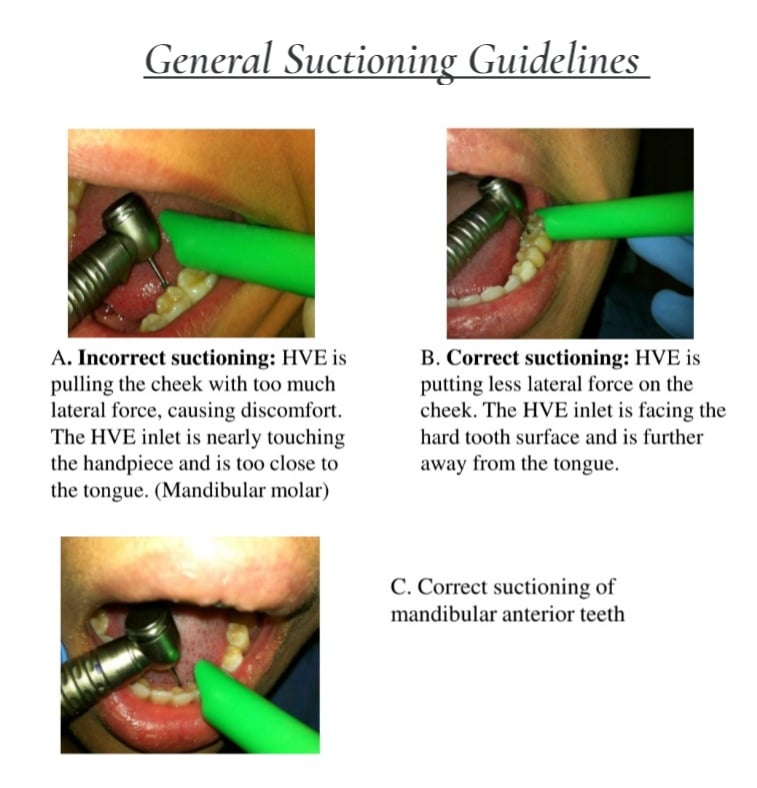Dental suction is often necessary to remove too much saliva and fluid during oral surgery. Suctioning helps to prevent choking and aspiration while maintaining a clean oral cavity during the procedure. In addition, a dental dam or cotton roll may be used where necessary.
Why do you need to suction?
Many individuals suffer from dental anxiety. Surgery is often necessary to treat tooth decay and cavities, broken teeth, and jaw and other oral problems. However, with the right techniques, dental suction can lower the risk of complications and ease dental anxiety.
You must also suction patients when:
- If their airway is blocked.
- They can not swallow saliva on their own.
- Tooth breaks during the procedure can lead to choking.
- Equipment breaks can lead to an immediate risk of aspiration.
- If the individual patient expresses discomfort due to excessive saliva or other fluids.
General Suctioning Guidelines
The main purpose of the high-velocity evacuator (HVE) is to remove aerosols from the environment and keep the tooth of interest isolated and dry. The main purpose of the saliva ejector is to reduce the pooling of saliva.
How to properly Use a Dental Suction: 6 Basic Suctioning Techniques
- Never place dental suctions down the middle of the patient’s mouth. This will
cause the patient to gag or choke. - Do not touch the dentist’s instrument or handpiece with the dental suction!
- Position the dental suction so that it does not obstruct the dentist’s mirror or the dentist’s line of sight, and does not suction intra-oral tissues (i.e. cheek, tongue, lips)
- An HVE should be placed opposite the side of the handpiece or instrument. The HVE inlet should be oriented slightly occlusal and lateral to the aerosol source. It should be placed no more than 1-2 cm away from the aerosol-producing instrument—close enough to adequately reduce aerosols, but not so close that there is excessive pinching or stretching forces on intra-oral tissues.
- Monitor if there is no broken teeth or equipment left in the patient's mouth to prevent an unexpected dental emergency.
- It is often necessary to reassure the patient. Here is How to Reassure Patients in Dentistry/Nursing
Examples of How to Properly Use a Dental Suction are illustrated below.
- Incorrect suctioning: HVE is pulling the cheek with too much lateral force, causing discomfort.
The HVE inlet is nearly touching the handpiece and is too close to the tongue. (Mandibular molar) - Correct suctioning: HVE is putting less lateral force on the cheek. The HVE inlet is facing the hard tooth surface and is further away from the tongue.
- Correct suctioning of mandibular anterior teeth
How to Choose the Right Dental Suction Device
Choosing the right dental suction for your patients during the procedure lowers the risk of complications and discomfort. Use the appropriate size that's is compatible with a wide range of attachments. For help selecting the right suction for your clinic, download this guide, The Ultimate Guide to Purchasing a Portable Emergency Suction Device.
4 Types of Suctioning Machines
- Manual Suction Devices: This device works with a battery. Many healthcare settings have moved away from it because it delivers inappropriate result. It works by squeezing a pump to create a vacuum.
- Wall-Mounted Suction Devices: They are used in many dental offices where patients are unlikely to need transport. Adjusting the settings, changing the tubing, and other strategies can reduce or increase suction power.
- Portable Suction Devices: They are small enough to be easily carried and rely on batteries to sustain their power.
- Makeshift Suction Devices: A long time ago before companies designed suction machines, healthcare setting have to use this device to protect their patient's airways —often use during battlefield and high-chaos locations.
Emergency Suctioning
Even a basic dental operation may become an emergency, particularly if a patient has a history of anaphylactic reactions, such as health risk factors. Emergency responders and dental professionals should be trained to operate promptly anytime a patient has trouble breathing due to anaphylaxis, aspiration, or unexpected vomiting. As a dental assistant, it is essential to know how to How to Properly Use a Dental Suction.



